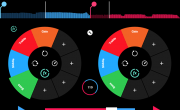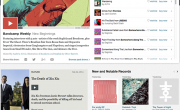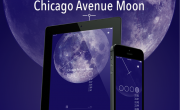Remember when telephones had one standard ringing bell to let you know someone was calling? Fast-forward to cell phones: first they had a standard set of 8-bit ringtone, then added more complex, layered, and melodious tones, and now they’ve become anything but standard. We can now use songs as the sounds we hear anytime someone wants to talk, text or video chat. Granted, phones are not the only scope of sound and music utilized as a signaling device in modern society–home doorbells, public transportation, and elevators come to mind as well. What though, would the world be like if sound stepped up to more a idiosyncratic role in identifying the “who’s who” among many of the interfaces incorporated into our everyday routines, like email and social media notifications?
The scenario described above might not stay hypothetical for much longer, should any of the projects happening around the world catch the wave of massively appealing trends and become a point of desire for everyday use. Organizations like Parametric Sound in San Diego, CA, who are developing a technology called HyperSound, and Jörg Müller and his research team at the Technical University of Berlin, who are working on a concept called “BoomRoom,” want to make it possible for sound to not only alert you when something needs your attention but to make each notice unique and with a sound isolated to just those who need or want to hear it–without wires or headphones of any kind.
The two projects, which were recently highlighted in New Scientist, have already put test runs in place for specific uses. HyperSound has been implemented by some US McDonalds locations for their in-restaurant TV monitors to project sound to specific tables. New Scientist describes the BoomRoom’s initial test method as an, “audio-based lightsaber game in which a blindfolded person had to react to the “zummm, zummm” of a digital adversary’s lightsaber, their voice or their breath on the back of their neck.”
The mechanics of how these two technologies function can get quite complicated (just take a look at the abstract in Müller’s paper linked above,) but the bottom line objectives promote envisioning rather futuristic capabilities inside homes and commonplace businesses. Right now, the idea of moving, activating, and manipulating sounds that are projected in the space around us, as if they were tangible objects, as the BoomRoom aspires, relies primarily on gesture and “flat panel actuators that act as loudspeakers by making glass and other flat surfaces vibrate.” These bases for operation seem to combine the best aspects of existing sound technology advancements that we have reported before, like the V-Motion Project, the Kinectar and Feonic Technology’s “Whispering Windows.” (Plus, it’s clear wireless gesture is indeed the next big sound trend, given some of the emerging companies featured in this year’s midemlab competition, like Sound Wand and Nagual Sounds competing under “Recommendation and Discovery” –the latter of whom turned out to be this year’s category winner.)
The one downside that does stand out amidst the potential for benefit beyond convenience, (e.g. better human sensory awareness) is that the idea of everyone having their own invisible ‘sound bubble’ comes across like a departure from trying to avoid perpetual electronically-driven distraction. Google Glass has already breached the psychological controversies of what it could be like if people are silently scanning information about each other from the web, while simultaneously appearing to maintain a face-to-face conversation with the person in question. Nevertheless, for however much paranoia or personal discomfort that proposal might inflict on one’s mind, at least Google Glass is visible.
You could theoretically assume someone is multi-tasking while talking with you, and possibly about you if you engage someone wearing the glasses. What if though, there comes a day when individual seats on NYC buses or the London Tube allow passengers to hear only what they want to hear, within the “space” of their seat? The end result wouldn’t be much different than the present scene of a NYC subway car full of passengers engrossed in music with earbuds or studio sized headphones but, at least then it is obvious who is not “available” to give their attention to another. Absent a tangible or visible cue, there might come a day where we (at least temporarily during various lapses of time) don’t notice others whatsoever, even if we are packed tightly among many other bodies in a single place. Visualizing a world where the boundaries of who is preoccupied becomes hidden, feels mildly disturbing for all the ensuing psychological isolation and external confusion it would foster–a literal manifestation of being “zoned out.”
Kira is an old school music nerd with a love for all things creative; always searching for music’s common ground. She graduated with an M.A. in Performing Arts Administration from New York University. Drop her a tweet @shadowmelody1
















Comments are closed.